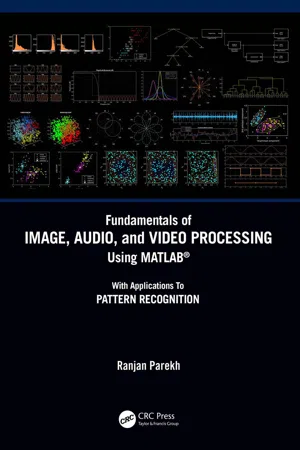
Fundamentals of Image, Audio, and Video Processing Using MATLAB®
With Applications to Pattern Recognition
Ranjan Parekh
- 388 pagine
- English
- ePUB (disponibile sull'app)
- Disponibile su iOS e Android
Fundamentals of Image, Audio, and Video Processing Using MATLAB®
With Applications to Pattern Recognition
Ranjan Parekh
Informazioni sul libro
Fundamentals of Image, Audio, and Video Processing Using MATLAB ® introduces the concepts and principles of media processing and its applications in pattern recognition by adopting a hands-on approach using program implementations. The book covers the tools and techniques for reading, modifying, and writing image, audio, and video files using the data analysis and visualization tool MATLAB®.
Key Features:
- Covers fundamental concepts of image, audio, and video processing
-
- Demonstrates the use of MATLAB® on solving problems on media processing
-
- Discusses important features of Image Processing Toolbox, Audio System Toolbox, and Computer Vision Toolbox
-
- MATLAB® codes are provided as answers to specific problems
-
- Illustrates the use of Simulink for audio and video processing
-
- Handles processing techniques in both the Spatio-Temporal domain and Frequency domain
-
This is a perfect companion for graduate and post-graduate students studying courses on image processing, speech and language processing, signal processing, video object detection and tracking, and related multimedia technologies, with a focus on practical implementations using programming constructs and skill developments. It will also appeal to researchers in the field of pattern recognition, computer vision and content-based retrieval, and for students of MATLAB® courses dealing with media processing, statistical analysis, and data visualization.
Dr. Ranjan Parekh, PhD (Engineering), is Professor at the School of Education Technology, Jadavpur University, Calcutta, India, and is involved with teaching subjects related to Graphics and Multimedia at the post-graduate level. His research interest includes multimedia information processing, pattern recognition, and computer vision.
Domande frequenti
Informazioni
1
Image Processing
1.1 Introduction

Image as collection of pixels.
Indice dei contenuti
- Cover
- Half Title
- Title Page
- Copyright Page
- Table of Contents
- Preface
- Author
- Abbreviations
- 1 Image Processing
- 2 Audio Processing
- 3 Video Processing
- 4 Pattern Recognition
- Function Summary
- References
- Index